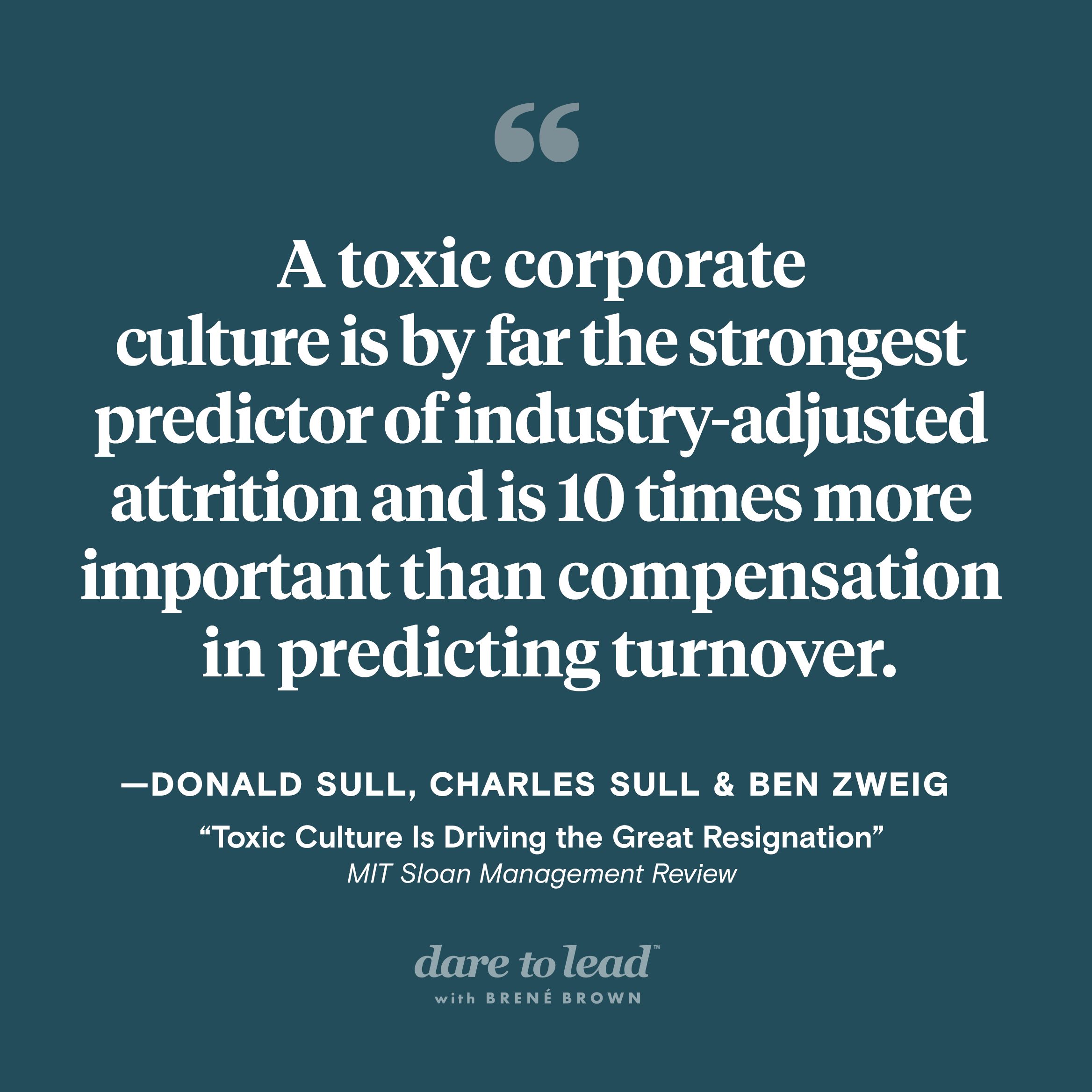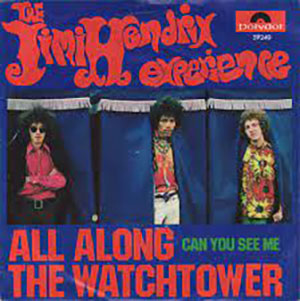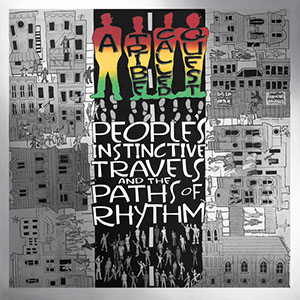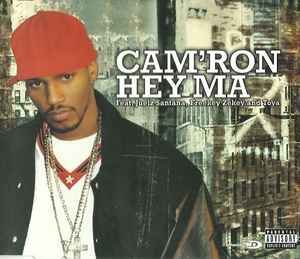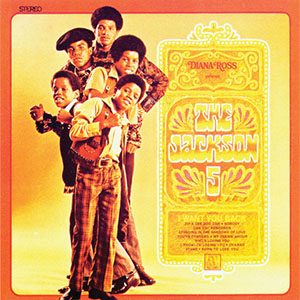Brené Brown: Hi, everyone. I’m Brené Brown, and this is Dare to Lead. Wooh, let me just tell you right now, you can listen to this podcast while you’re driving, or walking, or running, or folding socks, but you’re going to need to listen to it again, when you’ve got a pen, and a piece of paper in front of you. This is an incredibly… I mean maybe one of the most powerful Dare to Lead episodes we’ve recorded, especially in terms of data. I’m talking with Dr. Donald Sull, and Charlie Sull about an article I came across in the MIT Sloan Management Review, entitled “Toxic Culture Is Driving the Great Resignation.” So as we know, between April and September 2021 more than 24 million American employees left their jobs. It was an all-time record. Donald, and Charlie have done this incredible research into why people are leaving, what’s driving people out, what are the motivations behind the great resignation? It is both revealing and confirming to hear how their research connects with the work that we do with Dare to Lead. It is exactly what we’re seeing in companies all over the world. But I have to tell you this, I asked a question in the middle of the podcast, which is, “Can you define toxic culture for us?” And we dig deep into the definition of toxic culture, which is going to be published in an upcoming article by Don, and Charlie, and whoa, this is so important. I’m so glad you’re here to hear this.
[music]
BB: Before we jump into the conversation, let me introduce you a little bit to Don and Charlie. Don is a global expert on strategy and execution in turbulent markets. He’s published five books, and over 100 cases, and articles, including a dozen best-selling Harvard Business Review articles, and MIT Sloan Management Review’s most popular strategy article of all time. He’s advised top teams, and boards of more than 50 Fortune Global 500 companies, as well as non-business organizations, ranging from the Bill and Melinda Gates Foundation to the Naval Crime Investigative Services. Uh-oh, NCIS. Barrett’s laughing, I should do their theme song. He is a senior lecturer at the MIT Sloan School of Management, where he directs the Strategic Agility Project, and the Culture 500. He teaches courses on competitive strategy, and strategy execution. Formerly a professor at Harvard Business School, and London Business School, he has his Bachelor’s, Master’s, and Doctorate from Harvard. Don is the co-founder, with Charlie, and CEO of CultureX, a technology company that uses proprietary AI to help organizations measure and improve their corporate cultures. We’re going to hear a lot about the data they’re generating. It is… Whoa, blow your mind.
BB: Charlie… And Charlie and Don are actually father-son, which is, I think, really great. As someone that works with sisters, I like it a lot. Charlie’s the co-founder of CultureX, with Don. He has advised the senior executive teams of dozens of organizations on cultural management, strategy development, and strategy execution. He conducts regular research at MIT, and his thought leadership has been featured in The Economist, Harvard Business Review, MIT Sloan Management Review, Bloomberg, CNBC, Fortune, The Financial Times. With Don, Charlie created the MIT Sloan Management Review/Glassdoor Culture 500, the largest systemic study of corporate culture ever conducted. Charlie graduated from Harvard, where he was the president of the Harvard Lampoon, which is… I love that about Charlie.
BB: All right, let’s dig in. Again, get your notebooks out, get your pens out. If you’re moving, this is going to be one you’re going to have to listen to two, or three times. Listen to it the first time, second time get ready to take notes.
[music]
BB: Okay, so Don, and Charlie, welcome to the Dare to Lead podcast. Thank y’all for joining us.
Charlie Sull: Thanks for having us.
Don Sull: Yeah. Thank you.
BB: I am… I don’t even know if the word is fascinated, intrigued, freaked out by your article, that I came across in the MIT Sloan Management Review. The title of the article is “Toxic Culture Is Driving the Great Resignation.” And y’all have done some really persuasive research. The data are so compelling here. Can we talk about it? Can we walk through it together?
DS: Sure. The question we’re really interested in is in this great resignation, what’s driving people to leave their companies? There’s been a lot of talk about burnout, there’s been a lot of talk about compensation, and there’s been a lot of speculation about other things that might be causing that. And so what we looked at was we took a sample of about 600 companies, separated into 39 industries. Of course, there’s a lot of variation in terms of attrition by industry, so in apparel, retail, or fast food there’s a lot of attrition than other industries, they’re more stable. We controlled for that. So what we did was measure for each company how much higher its employee turnover was than its industry, or lower.
DS: That’s what we were predicting, and what we then looked at was about 125 aspects of culture, and other things that employees frequently talk about when they write the pros and cons in their Glassdoor reviews, and what we’re trying to do is use these aspects of culture, and other things that matter to employees to predict whether a company had higher, or lower attrition than its industry. And the very striking finding that emerged was the single best predictor was having a toxic culture, and that, indeed, is more than 10 times more predictive than compensation when it comes to understanding whether a company has higher, or lower turnover than its industry as a whole. There were some other factors, of course, that were predictive as well, but that was the headline finding.
BB: How do you define, or operationalize toxic culture?
DS: Yeah. We have a paper coming out in a couple of weeks on exactly this, and it’s a great question because if you go online and just read the first 10 blog posts that say, “Do you have a toxic culture?” And write down what they say that the symptoms of a toxic culture are. What you very quickly do is get 50 or 60 different non-overlapping symptoms. So, everybody agrees toxic culture is bad, but there’s very little overlap in terms of what constitutes a toxic culture, so the question that we had was, “What moves the culture from being annoying or somewhat bothersome to downright toxic?” Because you see in Glassdoor reviews, which is a data source we use frequently, the free text in Glassdoor reviews, people grumble about all sorts of things, my organization’s bureaucratic, it’s slow moving, it’s silo, blah, blah, blah. And then rate the company a five or a four. So, they grumble about lots of things, but again, the employees don’t provide much guidance on what makes something truly toxic. So, what we did in this paper, this forthcoming paper, is we took about 1.4 million Glassdoor reviews, and for every individual when they write a Glassdoor review, and they rate the company’s culture on a one-to-five-point scale.
DS: And so, what we were predicting in that case was their rating for the company’s culture, we had a company fixed effect as well, we had some controls, but that was the basic idea. And again, what we’re then doing was taking these aspects of culture and other things that employees talk about in the reviews to predict what caused a really negative review. Okay, so we weren’t so interested on the positive side. What caused really negative reviews? And what we discovered was there were five things we call them the Toxic Five, sort of the evil twin of the Fab Four. And the Toxic Five are… The first one is non-inclusive. So, we measure a set of topics, LGBTQ inequity, disabled inequity, racial inequity, gender inequity, overall discussion of diversity, overall discussion of inclusion. So, there’s a bundle of topics around people feeling like “I’m not being included. I’m not being treated fairly because of my identity.” And that bundle of topics is the largest single predictor of a negative review. So, if someone says, for instance, if someone mentions negatively in their review that this company does not treat members of the LGBTQ community with respect or well.
DS: That will… All of the things being equal will knock the review down by 0.65 on a five-point scale, so that’s really significant. That’s a huge, almost a jump. So, the first one is exclusionary, the second is disrespectful. If people… And Charlie maybe can go into this a little bit more, but if people talk about feeling disrespected in the workforce, this is a really strong predictor of a negative review. Unethical behavior, dishonesty, failure to comply with regulation, so there’s a bundle about unethical or integrity, unethical behavior, or low integrity. That’s the third. The fourth is cut-throat. So, it’s interesting in organizations, a lot of people will say, “You know, it’s really hard to coordinate across silos.” That’s normal, in complex organizations, right?
BB: Yeah.
DS: But we have some struggles, things don’t always work out great on our team. That’s fine. That’s the normal stuff, but cut-throat is actually beyond that. It’s when people are going out of their way to undermine one another, and that leads to a very negative review. And then the final one is abusive managers, so those are the five, and that’s the methodology that we use to identify them. And they really stand… When you look at the empirics, they really stand head and shoulders over literally hundreds of other things that people complain about or grumble about that don’t lead to such negative reviews.
BB: It’s so interesting because I would… Not inclusive, disrespectful, dishonest, unethical, cut-throat, and abusive managers, I would just call these the non-negotiables, these are the things that tear people’s lives apart, meaning these are the work issues that drive insomnia, depression, relationship issues with kids and partners. These are the things that you cannot keep contained to work. These are, to me, non-compartmentalize-able issues. Like you said, if I’m like, “Ah, man we’re too siloed over here.” Or, “There’s too many Slack channels.” Or, “The communication’s kind of shitty.” We can compartmentalize a little bit. I don’t see people being able to keep this experience at work. Charlie, I’m interested… I’m interested in disrespectful.
CS: Yeah.
BB: What does that mean?
CS: Well, you can really get a good sense of what it means when you read through hundreds or thousands of these employee comments. And I think the crucial distinction is actually kind of an emotional one. So just by the way of how I came to learn about you, Brené, I’m getting married this year, and my fiancée and I were reading a bunch of books like Gottman, and all these books about how to communicate better and so forth to prepare for our marriage. And one of them was Atlas of The Heart. So, thank you for writing that…
BB: I love it.
CS: It’s been very helpful. And yeah, it got me thinking about that section of the book, the places we go, when we feel wronged. And, actually, when you read through a lot of these employee comments, you can see a few emotions like anger and contempt really break through. For the most part, these employee reviews are very professional, kind of even tempered. But when you get to this segment of these toxic reviews, you see a lot of these very negative emotions jump out. And in particular, when you look at the reviews where employees feel disrespected, it’s a very interesting vocabulary that employees have.
CS: So they’ll have all these terms like, “I feel like I’m being treated like a cog in the machine.” Or “I feel like I’m being treated like cattle or like an insect.” All these different terms to convey de-personification, dehumanization.
BB: Yeah.
CS: And it’s very, very negative and very powerful place that they go. And you can actually see that reflected quantitatively, I think as Don was saying, when you look at the effect that a negative comment about disrespect has on a Glassdoor review, it’s about 18 times as powerful as the average topic we measure. So it’s really off the charts when you get to this kind of emotion.
BB: Wow, it’s almost an assault on personhood.
CS: You get that sense. You can really feel the pain jumping off the page in a way you really can’t for most topics employees mention.
DS: And if I could jump in for just one second. What we did in a separate study, we looked at what companies aspire to in their corporate culture. So we took a sample of about 600 large mainly US-based organizations and looked at their public statements of their corporate culture on their annual reports, 10ks, websites. And as it turns out, about 82% of companies have public core values or culture statements. And what’s interesting is the converse of the toxic five, respect, integrity, diversity, collaboration. These are all among the top 10 most frequently listed core values.
DS: So, part of what’s happening, I think is this is what the employers are promising to their employees, they’re saying, “Look, this is our culture.” And then the other thing is, as you were saying Brené, these are just fundamental aspects that people expect and when they’re violated… I came across a statistic, you might be familiar with this, I wasn’t, about this notion of when these really fundamental things are violated that the cost to employees, there’s a meta-analysis done by some colleagues at Stanford, looking at the medical costs or the medical impact, physical disease, not even… Leaving aside mental health, physical health. If someone’s working in a toxic environment, they’re between 35% and 55% more likely to be diagnosed with a major disease, cardiac disease, stroke, diabetes. So, for most employees the reality is, your boss has a bigger impact on your health than your doctor, it’s kind of startling.
BB: Yeah. This is what I’m talking about with, I don’t know a better word, the seeping power of these five that you discovered. These are not issues that displace us as workers, these are issues that displace us as humans, and the toll is so real. I could talk to y’all about this for five hours. I want to go back to the first article, and I want to ask, have you ever read an article and you’ve got more highlighted, then that’s not highlighted, and you’re like, “Damn, that’s not helpful. I need to be more discerning with my highlighter.” Okay, I’m going to read something, and then I want to ask you what you know or what you think about what I’m reading. “So, apparel retailers on average lost employees at three times the rate of airlines, medical device makers, and health insurers.” Was that because of COVID protocols and face-to-face customer service issue, what do you attribute that too?
DS: Well, so first of all, we don’t know conclusively. Our primary focus was controlling for industry and then trying to understand variance within industry. So now just preface it by saying that wasn’t the primary focus of this. What I will note is that apparel retail, fast food, specialty retail, some of the highest hotel and leisure, some of the industries with the highest rates of attrition are also, which again we’ll report in a forthcoming paper, are also the industries with the lowest scores on the toxic five on average. So, for instance, apparel, retail and fast food, specialty retail, all of them are in the bottom quartile across all 600 companies, 39 industries in our sample, in terms of disrespect, it being exclusionary and unethical behavior. So, my hypothesis would be that that probably is playing a role as well. Now that can’t be the only thing, because what’s interesting is management consulting is the second highest industry in terms of employee attrition, in aggregate in the first six months of the great resignation. And the companies included in that industry actually score quite highly on the toxic five, so that’s clearly not the only thing going on, but my suspicion is that’s part of what’s going on.
BB: Let me make sure I understand this first before we go on. On the toxicity instrument, the higher you score, the more toxic behaviors and the lower you score, the better off you are or the opposite?
DS: Well, the way we measure things, in terms of our methodology, what we do is we take the free text and then we run it through this NLP platform that we’ve built. This text goes in and every sentence is assigned to one or more topics of which we have 400 topics, and then there’s a sentiment assigned to them. So, we typically think of it in terms of, if you talk about this more frequently as an employee, that’s typically bad news, because everybody talks about the toxic five when you’re talking about… Discriminatory behavior it’s almost always negative, nobody talks about that positively. So, when we talk about more frequently, that’s worse than when we talk about it more negatively, although it’s typically so negative, there’s not a ton of variance on that dimension. So that’s how we tend to think about it. If you’re talking about it more, you’re talking about more negatively, and then you’re doing worse in terms of toxicity.
BB: So, when you’re saying that apparel, hotels and leisure specialty, when you say they talk about it more?
CS: Well, just to give you some metric. One metric you can use is, what percentage of employees on Glassdoor cite one of these indicators of toxicity negatively? And it’s surprisingly prevalent, so if you look across our overall sample of about 600 of the largest employers of America, about one in 10 employees is going to cite toxicity negatively on Glassdoor. And when you get to some of the industries Don was talking about, like fast food or apparel retail, that number can jump to closer to 20%. But the real variance is interesting, if you control for industry and you look at different companies within the industry, there can be a large amount of variance and that’s what we thought was especially interesting in this article.
BB: How smart was it to control for… It’s like industry adjusted. So, tell me what you learned when you held industry constant. Like, what surprised you?
DS: I’m kind of a strategy person, so it’s hardwired into my brain, and we always control for industry because we just know so many things that are important co-vary with industry, I guess. So what did surprise me was how much variance there is within industries. If you take some of these industries like grocery stores or apparel retail that really, on average, as Charlie said, that’s a great way to think about it Charlie, is negative percentage of employees. You mention it negatively, and you’re sort of 2x the mean for the sample as a whole. But then you go inside, and you look… Trader Joe’s, H-E-B, there are grocery stores, Wegmans, that have some of the lowest toxicity scores, lowest incidents of toxic mentions, and highest overall culture scores in the entire sample, so that’s, to me, the surprising thing. Well, you can be a saint in the city, right? There are some companies that industry is not destiny. And people say, “Look, oh, we’re an apparel” or, “We’re in fast food, and there’s just nothing we can do about. We have to treat our employees poorly to make money in this industry.” It’s just empirically not true.
BB: I mean, industry is not destiny, but I hear that every time I go into organizations, people will literally tell me I need to adjust my expectations because I don’t understand the realities of the industry in terms of how they treat people. You have in here, “Companies with a reputation for healthy culture”, you include Southwest Airlines, Johnson & Johnson, Enterprise Rent-A-Car, LinkedIn, “experienced lower than average turnover during the first six months of the Great Resignation.” True?
DS: Yes.
BB: This is what I have highlighted, then triple highlighted once my highlights meant nothing. Tell me about more innovative companies like SpaceX, Tesla, Netflix, and some of the things that you’re seeing in the data about their attrition and what might be driving that.
CS: That was one of the more surprising findings we uncovered during the research. So yeah, basically what we found was the more likely employees are to say that the company they work for is innovative, the higher the rate of attrition you’re going to see. And we thought that was kind of weird because you typically think of innovation as being this very positive thing, this is the reason why you join companies. But actually, when you look at other cultural topics that innovation is correlated with, you see there are a lot of aspects of work-life balance, like ambitious targets, heavy workload, that actually make it may be attractive to join one of these companies but hard to work at it for prolonged periods of time. And we think that’s what explains that little factoid.
BB: What else surprised y’all? I mean, to me, that was fascinating. And as someone that goes into tech companies pretty often, I was… What is the saying? I was surprised but not shocked. Everyone goes through the innovation, and everyone leaves because of the pressure of the innovation. I thought that was incredible. What else surprised y’all? Charlie, what did you say, “Damn, we need to check this again?”
CS: Social events: How powerful are the… Or attentive for social events are on a company’s culture? We find that it’s even more… If you want to retain employees, a better way to do it than to pay them more is to host social events where they can all get together. And these events are incredibly cheap. All you need is a place for them to gather, some drinks, some food. And our data suggests that’s an incredibly powerful way to retain employees, which I did not see coming.
BB: Wow. Don, what did you not see coming? What surprised you?
DS: I think one, that remote work arrangements weren’t a more powerful predictor. Although what I suspect is happening is that there’s so much convergence on remote work, there’s not so much variation in terms of remote work opportunities that are being offered, so it’s not differentiating companies. I suspect that’s what’s going on there. I thought also it was interesting that offering predictable schedules… And maybe not surprising, because there has been some very nice work on the power of offering employees predictable schedules. There’s a very nice piece of work done by a colleague at Berkeley where they actually did a randomized controlled trial with Gap stores where the treatment group had a predictable schedule, and the control group didn’t have a predictable schedule.
DS: And they saw increases in employee well-being and reductions in anxiety, particularly pronounced for employees with young families, which was terrific. So, it was nice to see that emerge from the data because like social events, I think where it’s nice about predictable schedules is there’s kind of two things going on. One, if you have a toxic culture, you have to address that, right? This typical company in our sample has about 60,000 employees. So, if you’re at the average, that means you have 6,000 employees who are getting a pit in their stomach every time they drive into the parking lot, okay? So that’s the average company in our sample.
DS: And what’s interesting is, what we see in the data is that there are pockets of toxicity, right? So it might be through acquired companies, it might be through functions or divisions, it might be attributable to a single leader. But there are also different perceptions by identity groups. So, you’ll sometimes see in some organizations that women or members of the LGBTQ community will have very different… Experience the culture very differently. And given how costly that is to the individuals, but also costly to the companies, I mean, when you think about this… And I was just with the top team of a very large tech company last weekend. We’re kind of going through this. And the cost to the company: One, attrition, this is a top predictor that you’re going to lose employees; two, it’s the top predictor that you’ll have a crummy Glassdoor review, which means it’s going to be hard to replace those employees.
BB: The talent, yeah.
DS: Yeah. Three, your employees get disengaged. I mean, the best estimates are something like a 20% reduction in productivity in employees who are disengaged because of a toxic culture. Most companies are paying the health bills of their employees, so if your employees are 35 to 55% more likely to get seriously ill, that’s coming out of your wallet. And, of course, there’s a reputational risk. Think of Wells Fargo. If a publicly traded company is caught committing financial fraud, they see between 25 and 40 percent of their market capitalization destroyed, never to be seen again. These are enormous costs for companies. So that is the fundamental thing that we want leaders to understand is even the healthiest cultures… This isn’t a reflection on you as leaders or saying your organization is bad; it’s saying even the healthiest cultures will have pockets of toxicity, which have horrible effects both on the individuals involved, most importantly on the individuals involved, but also on the company as a whole.
DS: And so, if you’re a board member or a shareholder or the head of HR or the CEO or the CFO, this is your problem, to address this. And, yes, there are these kind of shorter-term things you can do, or you can have the social events, and that’s terrific, and you have a more predictable schedule. Those are great things, but you can’t use that as an excuse not to identify and address these pockets of toxicity because there are thousands of employees in the typical large company in the US who go home feeling terrible every day because of the toxicity of their culture, and it’s just not acceptable, any way you look at it, it’s not acceptable.
BB: Let me try to pin you down on something… Charlie, maybe you can take this one based on what Don is saying. In the paper that’s going to come out or in the data that you have supporting that paper, did anything emerge from the data around the pockets of toxicity, are they more likely to be one area of a company than another, are they more likely to be a team of leaders, an individual leader, are they more… Do we know anything about the pockets?
CS: Well, it’s very interesting, the one thing we can say for certain that we know at the moment about these pockets of toxicity within an organization is that they’re heavily correlated with the leadership of the micro-culture. So, for instance, one analysis we can do is look at a large internal engagement survey where employees are saying, “Hey, I think the culture is toxic here, I think various things about the culture here.” And then another survey of managers direct feedback from, say, 360 reviews or performance reviews, and then those reviews, sometimes employees will say things like, “This manager is abusive,” Or more subtle red flags like, “This manager is abrasive and bad tempered,” Or something like that. And when you sum up all of these red flags on both axis, both the individual manager red flags and the micro-culture as a general red flags, they are very, very strongly correlated.
CS: So that’s what we found for the most part, and I often get asked the question, “Are there specific functions, marketing, research and development and so forth where toxic micro-culture is more likely to live?” That’s not what we found so far, it’s really mostly about the leadership.
DS: And if I could just jump in…
BB: Please.
DS: It’s absolutely right what Charlie is saying, we don’t see that in Glassdoor data that we see that when we have company data and we have super granular data and a lot of identifying information on the respondents to the surveys, what Charlie was describing is exactly right. The other thing I just want to say is this is not letting the top team off the hook, okay? Because it’s also the case, and we know this empirically, that the top team has an enormous impact on the culture of the organization, there’ll still be variance across sub-cultures, but they have an enormous impact. So just one really striking finding, if a CEO has served in the military, a company controlling for all the factors you could observe and think to control for a company is between 60 and 70, 60 and 70% less likely to commit corporate fraud. If the CEO has a DUI or traffic violation, a company is 25% more likely to commit fraud, but a one standard deviation in terms of how much employees trust the CEO is associated with a 6% increase in patents, so what Charlie is saying is exactly right.
BB: Whoa.
DS: But you cannot let the top team of the hook because, I’ve had this discussion with many CEOs over the past year and they’re like, “Oh yeah, yeah, I knew it’s those middle managers screwing things up,” And I’m like, “There’s an element of opportunities to improve that leadership team, yes, but it has to come from the top, because otherwise people can take cover from the behavior that they observe among top team numbers.”
BB: Yeah, and I think sometimes I wonder what your experiences have been, just kind of coming… Bouncing out of the article a little bit into kind of lived experiences, we’re going into organizations where everyone’s very clear about a specific leader’s behaviors either being not inclusive or they’re being disrespectful, just go down your list of toxicity, but in short runs, they produce, they produce, they produce, but no one talks about the cost of that production, and if you subtract the cost of that production from what shows up in the analyst call or what shows up on a balance sheet, I question how much they’re producing for the company. Do y’all see that? I see that.
DS: Absolutely, which is why… So, I’d hate to keep referring to this forthcoming paper, but it’s… This is exactly what we are doing.
BB: It’s no… It’s great. I feel like we’re getting a sneak peak.
DS: You’re getting a sneak peek, you absolutely are, but that’s why we’re so focused on quantifying the kind of hidden costs of toxicity. So, this is what it comes to call an externality, it’s a cost that’s very… It’s like pollution or climate change, it’s an enormous cost, but it’s not living on anybody’s income statement, so it’s easy for companies to ignore that cost and toxic culture is exactly the same. Of course, the worst thing is the impact this has on human beings and their families, they go home and it’s hard on their kids, and it’s hard on their parents, and it’s hard on their partners, that’s obviously the worst thing, but if you’re trying to convince a hard-nosed CFO of a publicly traded company, that may not necessarily be their first concern, that’s why we’re so focused on quantifying, “Okay, this is what it means in terms of attrition, in terms of attracting employees, in terms of productivity, in terms of your healthcare costs that are coming right out of your bottom line, in terms of the reputational and legal risk, these are real costs that as… ”
DS: In some ways, I hope we can shift the discussion to the board saying, “Hold on a second, these are real costs, and you as a top team, CEO, CFO, chief people officer, you as a top team, really have to be protecting us against these costs. The hard thing is, I think because the concepts of toxicity was so poorly specified and so nebulous that it was hard to pin down the cost, but once you say, “Okay, these are the elements, and here’s why we believe these are plausible components to constitute this idea of toxic culture,” Then you can go to the empirical research and say, “Okay, here’s what we know about unfair or low integrity organizations, here’s what we know about the impact of that.” That’s our agenda here is to take…
DS: My sense is most CHRO or folks in HR or in the people part of the organization, they get it, they’re very empathetic people, and they see these costs and they really feel for the people, and to some extent, our audience, I think is the CFO and the CEO and saying, “Look, this is your problem too, this is investors’ problems.” And trying to help them to see how costly this is, because then that becomes a spur to really take it seriously and start to address some of these pockets of toxicity whereas you rightly say, sometimes you’d say, “Look, he’s running our biggest division, he accounts for 40% of our operating cash flow, we’ve got to live with him.” No, you don’t, you don’t.
CS: And I’d say it’s hard to pin down the cost, but also in larger organizations, it can be hard to pin down the manager, it can be hard to pin down the micro-culture. I think if you’re in a smaller organization, you probably know exactly who these toxic leaders are and where in the organization that the culture is breaking down. But if you’re in a company with 50 or 100,000 employees, it can be very difficult to track this issue systematically. So, I think that’s another way we’re trying to change the agenda.
BB: Smart.
DS: And that’s a great point if I could just build on that. Basically, what we do in the startup that Charlie and I started based on this research is we’ve built this NLP platform that… My background, I’m a qualitative researcher like you, Brené. That’s for my dissertation on, I interview people and I read transcripts and code and try to induce the insights from that. So that’s very much the spirit of what we’re doing, is we’re taking the free text, either employees talking about their company, it could be on Glassdoor, it could be employee engagement surveys or employees talking about their managers, 360 upward feedback. And then based on human beings kind of spending a lot of time with this and reading them and coding it and then kind of folding in theory where it fits, and then finding spots where we identified something that employees talk about that wasn’t so prominent in the theory, adding that as well, then we’re taking that data to try to see, “Okay, how are leaders doing? How are sub-cultures within the organization doing? How is the culture as a whole doing?” One of the challenges with toxic leaders is people are afraid of retribution.
BB: Oh, yeah.
DS: They’re classic case of Amy Edmondson psychological safety being violated. The more toxic the leader, the more afraid employees are to speak freely. So one of the things you have to do is be able in the language to notice subtle cues. So, one thing we’ve been doing with our colleague, Charles O’Reilly at Stanford, who’s Charles along with Jenny Chatman, two the most influential folks in thinking through culture systematically and empirically, is looking for, “Okay, what are the attributes of narcisstic leaders?” And nobody… We have a company, 5,000 leaders, no one says the word narcissistic in 10 reviews on average per year. So, 50,000 years, nobody says narcissistic. But we know, empirically, it’s going to be somewhere between 1% and 5%, maybe as high as 10% of those leaders have narcissistic characteristics.
DS: How can you see that if people are afraid to call a narcissist a narcissist? Well, there are traits that narcissist demonstrate. They’re set of attributes, one of which is they really have trouble taking feedback and people will talk about that. But they’ll couch it. They’ll say, “So sometimes you get a little upset when you get negative feedback.” And what you can do is look for patterns in those subtle cues, and then you can see, even though nobody comes right out and says this person is a narcissist, this pattern of cues, it’s not just positive, it’s not definitive, but it suggests that somebody might want to look a little deeper and helps to address this issue that Charlie’s mentioning, which is in larger organizations, you see it if it’s in EVP, because EVPs are high visibility, but the folks buried deeper in the organization who might be causing a lot of pain for their employees, you can start to identify those folks.
BB: Yeah, it’s interesting, I think the relationship between how toxic leadership affects employee voice is really powerful, and I think it doesn’t just affect employee voice down. I think it affects employee voice laterally and going up, because normally, if you’ve got someone that has a lot of toxicity as a leader, other leaders below and laterally see protection there, and are aware. It becomes self-preservation and so I love the subtle cues, I love what are specific behaviors that ladder up against a label that people are not going to use for safety reasons? I mean, I think that’s so smart.
[music]
BB: Let me ask you about the four actions that managers can take in the short term to reduce attrition. When is the article on defining toxicity, when is that coming out, and where can we find that?
DS: What did they say? Middle of March, Charlie, do you remember?
CS: Yeah, it should be less than a month from now. It will be out on MIT Sloan Management Review.
BB: MIT Sloan? Okay, great. Four actions managers can take in the short-term to reduce attrition. So going back to… We know the big reason people leave. Let’s talk about the other reasons. Let’s do that before we go here. So, number one, without a close second, I think it’s fair to say is toxic corporate culture. Two, job insecurity and reorganization. Three, the high levels of innovation, which we know can lead to really high stress, long hours, constantly shifting priorities, all the things that are happening in these companies. Failure to recognize performance. And then the last of the top five, poor response to COVID. And would you agree that… Well, not agree. They’re numbers. It’s an empirical question. Toxic corporate culture, 10.4, the second one is 3.5 with job insecurity and reorg.
DS: Yeah, and bear in mind, the way we’re kind of normalizing here to make the numbers more intuitive for people is that’s how much more important it is in predicting than compensation, which is in and of itself an important thing. It’s in the top 10. So, there’s no question that really is the dominant predictor. And parenthetically, it’s also we see the dominant predictor of very low scores in the Glassdoor reviews. So, it’s very consistent with other research we and other folks have done. I say on the job insecurity, that’s an interesting one to kind of emerge from the data. So, the way we came up with our topics, our cultural topics is first of all, we started with the companies. Like, did the study, 500 companies, what do they say their official cultural values are? And it turns out there about 65 cultural values that are listed by more than 1% of the companies in our sample.
DS: So, there’s that list, then we have the academic literature, and there’s the Charles O’Reilly and Jenny Chatman have a kind of taxonomy of cultural values, we used that and other sources. But then again, I’m an inductive researcher, so we read a lot of reviews and we tried to understand what are the topics that aren’t being covered by when companies say they aspire to culturally what other people focused on in terms of their research. And one of the really big ones that emerged with reorganizations and job insecurity, which are typically not considered part of culture, but if you think about from an employee’s perspective, that’s having a huge impact on their day-to-day life.
BB: Oh, God.
DS: It’s a sort of Damocles that’s always hanging over their heads. And by the way, I think reorganizations, correct me if I’m wrong in this, Charlie, but I think it may be the lowest average sentiment of any topic we have. There’s literally no one has ever in the history of history spoken positively about re-organizations, so… That’s interesting, the failure to recognize employee performance, there’s an interesting twist there… Much of the discussion of great resignation has just been about raw attrition numbers or raw turnover numbers and not taking to account like, “Hold on a second, who are the people that are leaving?” And it could be what this is suggestive of, and again, this wasn’t the focus of this research, so we’re speculating a little bit here.
DS: But what this suggests is, employees are more likely to leave, if they feel like hard work is not recognized and slacking is tolerated. Well, who are the employees that are most likely to be bothered by those things? Probably one would guess your high performers. So, what it could mean is those top-line attrition numbers are even worse than you think, because it’s not the average employee necessarily that’s leaving, it could be your top performers who are heading out. That was kind of interesting I thought.
BB: It’s interesting too for me because… I’m going back to this, because as someone who studies emotion and studies shame and courage and vulnerability, I wasn’t surprised to see re-org in number two, because I think one of the things… Again, if you’re talking about issues that we’re not able to compartmentalize as a social species. One of the things that happens in re-org is the proliferation of stories and fear in the absence of data and communication. So as a social species in the absence of data, we make up stories, and that’s never more prevalent than in organizations that are going through a re-org, there’s so many stories. And so, it’s one of the issues outside of what you’re calling toxic culture, which I just agree.
BB: I love your categories… That in the midst of re-orgs, there is such… Just everywhere you turn, stories driven by scarcity and then fear and uncertainty, that I don’t find that and the people that we interview, that is not something they can keep compartmentalized to work either. They’re in carpool line, that seeps too, that seeps along with disrespect and all of the other ones that you found. We’re not wired for it.
CS: Yeah, and I don’t think it’s a coincidence at all that the topics we’re not wired to handle like the toxic five or reorganization are the ones that are the most powerful quantitative drivers of these negative ratings. I think it’s an interesting link.
BB: It’s an incredibly interesting link, and don’t think I won’t be quoting this research… When I’m trying to tell people we are such emotional beings, that we are not just cognitive beings who on occasion are plagued by a feeling, we are emotional beings, who on occasion think. You can’t shame people at work. When I look at your list of toxicity, it’s like not inclusive. What does that mean? It means the hard wiring, DNA-born, need to belong. You’re just pushing up against some very primary needs of being human, to be seen and known and valued. The cutthroat part is… You know what I think about the cutthroat part because you immediately… I hear what you say, and I always think about… As a social worker, my training is systems or systems or systems. So organizational systems, family systems. I think in cutthroat environments, if you think about an abusive family system, where siblings turn on siblings often, what that creates is what we call an eggshell environment.
BB: So, a cut-throat environment is an egg shell environment, you never know where to step. You can’t predict what event is going to lead to someone turning on you, and so just the absence of trust and the foreboding sense of betrayal. I think what is so powerful about this work is it is so technically empirically based, and the findings are so deeply human that y’all are talking about. These are fundamental needs of people.
CS: Absolutely. So, this research mostly focused on very toxic cultures and what links those kinds of cultures, but we’ve also done a lot of more positively focused work. And a recent study we did was called the culture champions, where we look through our large sample of 600 largest employers in the United States, and which ones had across various dimensions the most remarkable cultures. And when we took that sample of, I think it was 23 companies, and we analyzed them based on these hundreds of cultural topics that we measure at CultureX, the single one that they all had in common to the largest extent was psychological safety. So, if you have this ability to really speak up and say, “I don’t think this is working”, or to say difficult things, we find quite a lot of evidence that that’s kind of the secret sauce of a really remarkable culture.
BB: Isn’t that incredible? I think about project Aristotle, I think that trust, safety, vulnerability, the ability just to be human, it’s powerful. Okay, I want to go back and close before I have rapid fires, I’m so excited about the rapid fires… I have no idea what to expect, and so I’m really excited. But let’s close this, going back to the article on toxic culture as driving the great resignation. Four actions, managers can take in the short term to reduce attrition, provide opportunities for lateral job moves. Why? Why is this important? Why is it relevant?
DS: A lot of people want variation, want to learn, but don’t want the additional headache and stress of a promotion. We also see this as global opportunities for multinationals that for whatever reason in their lives or their preferences, people want to change, and want to shake things up. People are learning beings, I’m a teacher, I see this all the time. Adults, young people that want to learn, and lateral opportunities provide that without the additional responsibility and stress and hours of taking on more responsibilities of promotion.
BB: That just makes sense. I’ve never in my life thought of that until right now. That’s so important. Offer remote work options. This is such a dicey topic right now. What is y’all’s thinking about this? So how does offering remote work options help to reduce attrition? And what are your global thoughts about the return to work, the not return to work? The hybrid… What are y’all thinking?
DS: Well, Nick Bloom at Stanford has probably the best empirical data on what is likely to emerge in terms of on-site hybrid and work fully remote, and where Nick comes out… And this across all companies, all industries so there obviously will be variants across specific companies. But where he estimates is about 60% of employees will be on site all the time, frontline employees, many of them. About 30%-ish of employees, 35% will be hybrid, and the most likely equilibrium is three days a week. Probably Tuesday, Wednesday, Thursday, everybody the same three days, so you have some go-to location. And then about 15% fully remote. So, if you take those numbers as broadly indicative of where we’re heading, to me, the big question is, what does culture mean when you have three classes or castes of people?
DS: Because by the way, this is not the same composition of employees, the people who are there all the time, many of them will have jobs that require lower level of education, the wages are likely to be lower, two-thirds of the US workforce does not have a college degree, and many of them will be in positions where they’ll be expected to be on-site all the time. And then the 15% who are fully remote, a lot of them are probably full stack engineers and AI experts. And so, they’re going to have highly educated, highly in demand, very fluid labor markets with lot of intermediaries, so they can jump from company to company quite easily. And then you’re going to have these people in the middle, and again, we don’t know how this is going to play out, but the odds are quite high those are going to be the connective tissue of your organization. Those are going to be the leaders trying to maintain some sense of community across these different groups.
DS: And just going back to Ted Lasso, can you imagine Ted trying to hold together the team, if 15% of them were remote and a third of them were only there a few days a week, I don’t think we’ve even started to think about how hard that’s going to be. And so, what you see as a result, I think, some leaders and organizations that are very focused and serious about culture like Netflix or Goldman Sachs whether you like the culture or not leave that aside. But it’s just that they take culture very seriously. They’re pushing for, “We’ve got to have folks back, we haven’t yet figured out the way to maintain the culture we want if the workforce is fragmenting like this.”
BB: Charlie, you have thoughts?
CS: Yeah, the only other thing I’d say about the link between remote work and toxic culture is there’s some pretty interesting Glassdoor data. So, if you look at average employer ratings on Glassdoor over time, the two years before COVID hit and since COVID, there’s actually been a really large bump that we call the COVID bump. So, the overall rating, the quantitative rating gets higher over time, and you also see a lot of these really negative topics that we mentioned, including toxicity, become less pronounced. And another big shift you see, of course, is the prevalence, increase in incidents of remote work. So, what we think might be going on here is if more employees are working remotely than the really kind of in-your-face aspects of a toxic culture like an abusive manager become less pronounced, so you’re going to be less likely to cite the culture as toxic.
BB: God, it’s… Keep thinking about that curse, “May you live in interesting times.” Like, this is it. Okay. So, we talked about sponsored corporate social events. As a CEO, I can’t even express to people the ROI on those. It’s so meaningful and so fun, I love them. And it’s so meaningful to our people. A lot of the work we’ve been doing with organizations during COVID is basically people will call us when they say, “Our people are not okay.” And so we’ll talk about ways to incorporate checking in on people and seeing people and validating people and hearing people remotely.
BB: And it’s just like this simple moment, but one of the people on our team is a therapist and she runs the graduate internships where people getting graduate degrees do our work in non-profits here in Houston. And it was her turn to come up with the check-out question for all hands, and so she asked this question and I thought about… It was so powerful. People got really emotional, she said, “For the check-out question, I want to know what you would be sharing with us if we were just at the bar in the kitchen, eating lunch together? Something that you don’t think is important enough to share on Zoom, but if we were together, we would know about it happening in your life.”
BB: And people got… Like they said, “I got a new cat.” “I closed on my first house,” “I bought a new car.” “My dad moved in with us.” That’s why I think the events are not about… We have a no alcohol policy, just because I’m a sober person, and the nature of our work makes it make sense. But it’s not about the booze or the food or the string quartet, it’s really about people getting to see each other in a different context and talk about things that, as you said earlier, Don, it’s connective tissue. I love this finding; I just love this finding and don’t think I’m not going to be having an ’80s party soon. All hands. Yeah. Suzanne’s in the room with me, she’s like, “Yes,” because she’s my age and we’re old. Last one is make schedules more predictable for frontline employees. Okay, I… Again, I do a lot of organizational work, I didn’t know schedules were not predictable. Teach me. Why do you say that Charlie? I didn’t know schedule predictability was an issue.
CS: Well, yeah, it’s an oxymoron but you have a lot of these cases, particularly in industries with a lot of frontline employees, like grocery stores where you think you don’t have to work on the weekend, but then on Thursday night, you get a call saying, “Actually, you’re supposed to work on Friday or Saturday.” So that’s what we mean by predictable schedule. It’s interesting because we measure many different aspects of a schedule. So, for instance, how flexible the schedule is, how arduous the schedule is, and those didn’t pop up as prominently on the analysis, but when you take this one specific attribute of this schedule away predictability or when you give it to employees, that makes them a lot more likely to stay in the organization.
BB: Can I ask, it’s not like I just came out of the womb as a researcher with a podcast. I waited tables and bartended for six years. I’ve worked retail, I never experienced unstable or unpredictable schedules, even in those jobs. Has that become worse?
DS: I think so. So, I have a colleague in Atone, who’s focused on good job strategy. And from the discussions I’ve had with her and from her research, it appears that it has become more… That companies have become more… There are a set of markers by which the lives of frontline employees has gotten worse over time in terms of unionization, wage, benefits and so forth, and I think this is just another way in which companies that are not H-E-B or Costco or Wegmans or Trader Joe’s just another way that they’re screwing employees.
BB: God.
DS: My first job was at Kentucky Fried Chicken scrubbing, cleaning floors and washing dishes. And I thought that was miserable back then but apparently, it’s got a lot worse.
BB: I can just think back to waiting tables, we got schedules on Fridays, and if people didn’t show up… They couldn’t change your schedule for love or money. They could call you and say, “Hey, tuition time, do you need to pick up a double, are you interested?” But they couldn’t make you come to work. And so, I just want to say a shout out… I probably shouldn’t, but I’m going to shout out my grocery store and one of my favorite teams to work with in the whole world is H-E-B.
DS: We love H-E-B. One of by the way, empirically one of the best cultures in America, just pretty much any way you cut it. Super… And what’s interesting about H-E-B… And not saying just H-E-B because Costco is like this.
BB: Love working with Costco too.
DS: In-N-Out Burger is like this, there are other examples… We have another paper coming out probably in about six months on companies that… Sort of the same in the city article, which is companies in very… On average very bad industries that have fantastic cultures. H-E-B is in that sample. And one of the things that’s interesting about those companies is they score much higher on the toxic five, which is not surprising.
CS: Much lower on the top.
DS: Yeah, sorry. Much lower top. Sorry I keep inverting that, I apologize. But they’re much less toxic. Where there’s the biggest difference in that group of companies versus their competitors in those industries is around health and well-being, physical health. But also, actually turns out mental well-being is the single feature where there’s the biggest difference between employees in the H-E-B’s and the Costco’s of the world and Safeways or the Kroger’s of the world, not to pick on them, but they’re not in that sample.
DS: That’s the single biggest difference. So, this is… Back to your point, is having profound impacts on those things that you can’t compartmentalize, and the other thing that’s very unique is you might think, “Oh well, they must have lower profitability because they’re treating their employees better.” No, on average, these companies have 25% higher revenue per employee than their competitors. On our measures of operational efficiency in terms of having a good strategy and their processes and their efficiency, they score higher. So, there’s this perception, it’s a trade-off like, “We either have to squeeze the last ounce of effort out of people and discard them, or we lose money.” The data… That’s empirically not true.
BB: God, I love this. Okay, y’all ready for your rapid fire? I’m going to choose who goes first in each one of these. Charlie’s so wired in. Charlie, go first. Fill in the blank for me. Vulnerability is…
CS: I’m bad at emotions, I’m bad at naming emotions Brené, this is why I need your…
BB: What does it feel like for you? Vulnerability feels like what?
CS: I was in this humor society in college, and vulnerability feels like saying your first joke in that society where everyone is a little judgmental.
BB: Yes. Okay, Don? Vulnerability is…
DS: Having to do something new every day as an entrepreneur [chuckle] and not knowing what you’re doing half the time. That’s what it feels like.
BB: Y’all are so good at this. Okay, Charlie, last thing you binged and loved?
CS: I’m currently binging The Sopranos for the 12th time maybe. And that’s going to be it.
BB: Would you go down as best series in American television? Better than Breaking Bad?
CS: I would say so, yes.
BB: Okay. Damn, he’s throwing down. Okay Don, last series you binged and loved?
DS: Ted Lasso, I’m watching for the second time and adore. But I have to say The Wire is the greatest TV series in history. Just to be clear, that… Again, that’s a factual point so I just wanted to make sure we’re clear on…
BB: He empirically dated you. Charlie…
DS: Yeah, yeah.
BB: He got factual. Okay, I like this question. What is one piece of leadership advice… I’m going to ask you both for the answer. That was so good that you have to share it with us or so shitty, you have to warn us.
CS: So mine comes from… Now, as I mentioned early, a couple of years ago, a large part of my job was just reading through these thousands and thousands of employee comments. It’s about the AI and there was this one comment that stuck in my mind, because every single thing she mentioned was a red flag of toxicity. It was the most red flag of all red flag reviews, I’ve ever read, pretty much everything we covered in research was in that review. And then at the end of the review, there was advice to management, and that was very short. And all she said was, “Learn how to speak without hurting.” And that’s I thought was pretty good advice.
BB: Whoa. That’s good. That’s powerful. Yeah, people can be scary when they’re scared.
CS: Yeah.
BB: Don, best piece of advice you need to share or worse piece so shitty you have to warn us?
DS: So share and it’s, if we have data, let’s use the data, if we have opinions, let’s go with mine. Because it captures two things that are critical. One, I am persuaded by data and two, the flip side of that, this quote is attributed to Jim Barksdale, I can’t remember who told it to me, but I love it. The flip side is if we don’t have the data… If we have to go with opinions, let’s go with mine. And what’s really neat about that as you think about, okay, whose opinions are going to count in the absence of data? Well, the most senior people or the loudest people or the most aggressive people or old guys, so I really think of data as a force to counterbalance people dominating a discussion who really shouldn’t be able to dominate the discussion and it’s also a great reminder of to me of how often my opinion is wrong. So I love data because it decreases the odds that we go with my wrong opinion.
BB: I like the way you think of that, it’s really neat. I’m taking both of the pieces of advice. All right, Charlie, what’s one thing you’re really excited about right now? I know what you better say.
CS: Getting married this year, so I’m pretty excited about that.
BB: Congratulations. Super exciting.
CS: Thank you.
BB: Don, what’s one thing you’re really excited about?
DS: The same. So, Charlie, and then our oldest daughter is getting married, so those are by far the most exciting things. Although it’s making it very awkward for… We have four kids and our son in the middle. [chuckle] He’s in a vice right now. His mother and I are giving him no peace.
BB: He’s in the marriage vice.
DS: He’s under tremendous pressure. But yeah, we’re super, super excited about that.
BB: Okay, this is a personal one that I added. So, I work with both of my sisters every day.
DS: Oh, great.
BB: Y’all are father and son. What’s one rule when it comes to working together that y’all think is really important?
CS: I’m sure we have a lot, but I don’t think we’ve ever really formalized them.
BB: What’s one thing you’re mindful of then, that is probably unspoken, but it’s…
DS: For me, it’s apologize when I’m wrong, or enthusiastic and sometimes perceived as forceful. I don’t perceive myself that way, I don’t mean to be that way, but I know I can be, like, “Let’s really do it this way.” And then afterwards, I just feel like, “Oh, that was… I was a jerk.” So, recognizing that and apologizing rather than just letting that linger.
CS: Yeah, I’d say it’s probably around psychological safety for me. It’s feel free to speak candidly. I think there are a lot of times where it might look like to an outsider like me and Don we’re having an argument or something, but that’s really just us kind of speaking candidly. And I think one of the good things about working together as father and son is that you do have this much deeper underlying bond that lets you communicate better in a lot of ways.
DS: And the thing that I’ve learned, which has been super surprising to me, is super helpful, I now, by working with Charlie, it’s just been fantastic and really fun and really enjoyable, but it’s also shifted how I think about leadership. So, I’m the CEO of this startup that we’re doing, and then… But I have student teams, I work with other doctoral students and other startups and so forth, and it’s really… I now think whenever I’m… Or try to remember any time I’m dealing with any person on a team or young person is, “This is somebody’s Charlie.” Because sometimes I get too task focused or I’m too focused on like, “I want to provide good, clear feedback to help people to get better and maintain high standards,” but just realize like, “This is somebody’s daughter or son, and am I sure that I am thinking in their best interest and I’m not getting too carried away with the task orientation.” And remembering categorical imperative, that people are never a means to an end, they’re always an end into themselves. Which is easy for your kids, you’re always with your kids, you’re always thinking like, “What’s best for them?” So, I’m trying, I hope I’m getting better, I’m not saying I’m great at it, but it’s really been a very helpful shift for me.
BB: Yeah, I think ours is really a combination of everything you’ve said, which is, apologize and circle back, don’t leave things unsaid, because then that drips into the weekend barbecue, and so, yeah, I think that’s a big one. It’s so funny that you said that about somebody’s Charlie, because our Slack photos in our company-wide Slack are all kid photos of ourselves, and it really does give you pause and make you think twice before you lose your mind, which you probably shouldn’t be doing on Slack anyway. All right, here we go. You’re mini mix tapes. You gave us five songs you couldn’t live without. Don, we’ll start with you; “All Along the Watchtower” by Jimi Hendrix, JS Bach “Cello Suites” by Yo-Yo Ma, “Can I Kick It?”, A Tribe Called Quest, “Dog Days Are Over” by Florence and The Machine, and “Pancho and Lefty” by Townes Van Zandt. You’re just flirting with me on that last one, but okay. In one sentence, and I have to warn academics, no semicolons, em-dashes, or carry-ons. In one sentence, what does this playlist say about you?
DS: That I am eclectic.
BB: [chuckle] Fair enough. Charlie? “Every 1’s a Winner” by Hot Chocolate, “Dear Prudence” by The Beatles, “Hey Ma” by Cam’ron, “Come Together” by Primal Scream, and “I Want You Back” by the Jackson 5. In one sentence, what does this mix tape say about you?
CS: It says I really like The Beatles but felt obliged to choose four other artists for the list too.
[laughter]
DS: Which is true, he loves the Beatles. He does love The Beatles, since he was a kid, I mean crazy, since he was a toddler, he loved The Beatles.
BB: Isn’t that funny? Well, it has been a total joy to talk to y’all, thank you so much for walking us through, not only this paper, but the one that’s coming. I am compelled to tell this story. So Karen Stout was my mentor in my master’s program, and she died before I started my PhD program, died very young of breast cancer, and she studied femicide, the killing of women by intimate partners. And I was the first person to really get into qualitative research in my college, and it was an ordeal. And she was a quantitative researcher, and I was at her house one night, back when graduate students still went to professors’ houses for dinner and washed dishes with their kids and talked shop, and there was a big fight in our college, quantitative or qualitative, what’s more important? And I remember Karen turned to me and said, “Don’t ever buy into that argument.” And I said, “Why?” And she said, “Because all the work I do, I really do for domestic violence survivors, and it would be so great if I could testify in front of the legislature or I could go to a funder and all I have to do is tell one compelling story and they would give me money, but they won’t.”
BB: “And it’d be really great if I could go and just give them data, just numbers, and they’d give me money or support, but they won’t. The stories matter, and the numbers matter in equal measure. And anyone that tells you that there’s some kind of false separation between those, they don’t understand the full scope of what research and data can do.” And so I’m so grateful for just the stories and the data and the numbers. What you’re doing is really important, and I’m grateful for it. So, thank y’all.
DS: Thank you for having us. This has been terrific. Pleasure.
BB: Yeah. We’ll link to all of your articles, and we’ll look forward to the next one.
DS: Yeah, we have a series of I think pretty interesting pieces coming out.
BB: Yeah, I can’t wait to share them with everybody. Thank y’all so much.
CS: Thank you.
DS: Terrific, thank you.
[music]
BB: Well, I hope y’all found this conversation as enlightening as I did. It was really both shocking and confirming. I don’t know how those two things can both exist, but they do. You can find the article that we talked about today, “Toxic Culture is Driving the Great Resignation,” on the MIT Sloan Management Review site. One of the things I love about this journal is the articles are reasonably priced, and I think you can add a couple of dollars to the price and get it to share with teams, so it’s great. We’ll put all kinds of links on the Dare to Lead episode page, so you can get to Charlie and Don, find their stuff, find them online at culturex.com. It was such a good conversation. All right, church bulletin. You know that thing where you’re like, “Oh my God, I’m starving, I’ve go to pee, I’ve got to get out of church.” And they’re like, “One last minute for announcements, we’re collecting money for the organ repair.” These are like those but more interesting, hopefully. The trailer for the HBO Max series on Atlas of the Heart is going to come out later this week, on Wednesday, March 9th. I’m so excited and petrified because, you know…
BB: It’s weird to be on TV, I guess. We are premiering the first episode of the series is South by Southwest on March 11th, which is really exciting. Also Ashley and Barrett’s birthday. Woo woo.
Barrett Guillen: Woo woo.
BB: Late 50s. How does it feel?
BG: Not even close.
BB: Okay, whatever. The full series is going to drop on HBO Max later this month, on Thursday, March 31st. I can’t think of any other bulletins. The Gifts of Imperfection is out in paperback. Oh, and my anthology with Tarana Burke, You Are Your Best Thing, out in paperback. Oh, that book was a life changer for me. All right, y’all, that’s all I’ve got. Stay awkward, brave and kind. And we are going out for spring break, so we’ll be off for a week. Just to let you know. Thanks y’all.
[music]
BB: The Dare to Lead podcast is a Spotify Original from Parcast. It’s hosted by me, Brené Brown, produced by Max Cutler, Kristen Acevedo, Carleigh Madden and Tristan McNeil, and by Weird Lucy Productions. Sound design by Tristan McNeil and Andy Waits, and the music is by The Suffers.
© 2022 Brené Brown Education and Research Group, LLC. All rights reserved.






